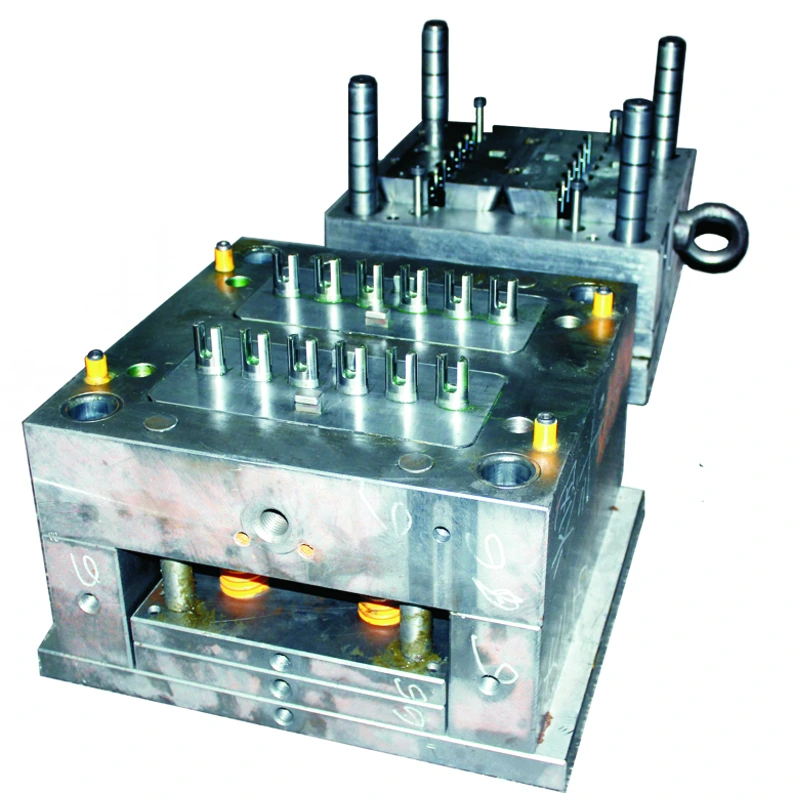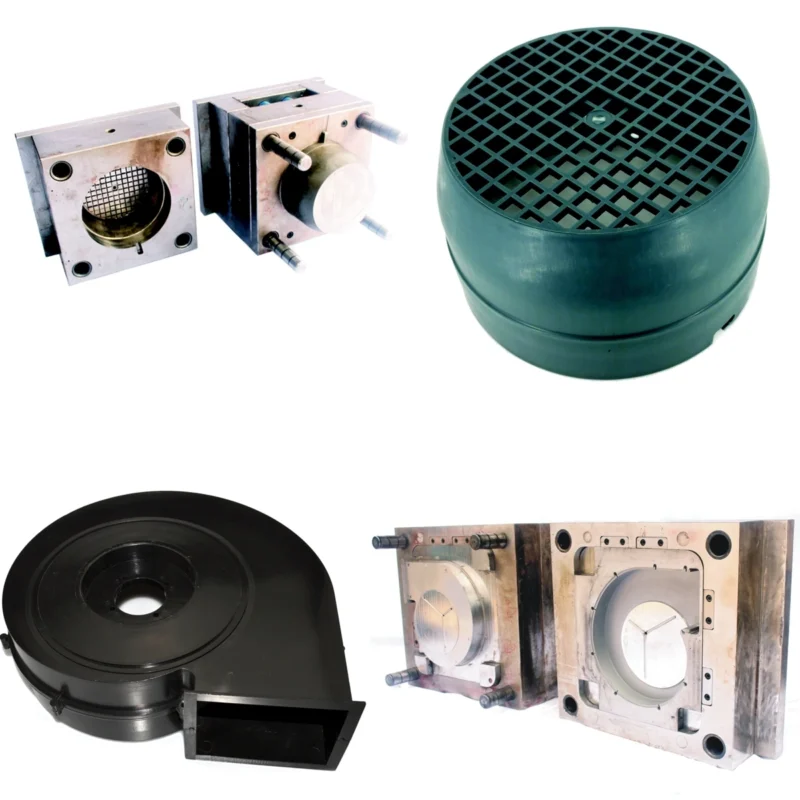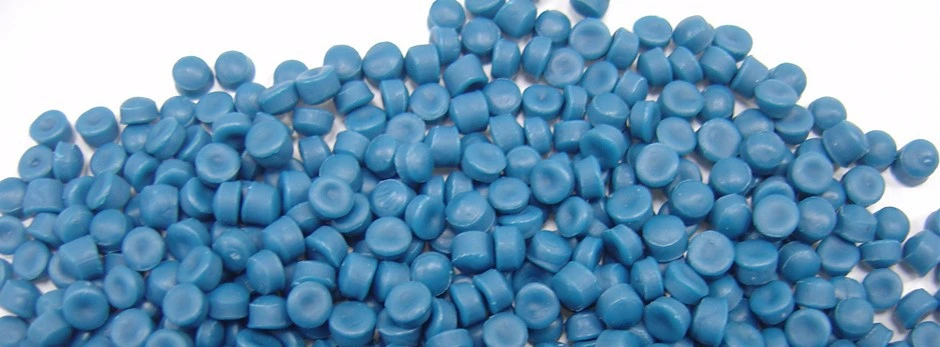The plastic injection molding process is a highly versatile and efficient method for manufacturing plastic parts. It involves several stages, each crucial for producing high-quality parts with precision and consistency. Here’s a step-by-step explanation of the plastic injection molding process:

Step-by-step Explanation of the Plastic Injection Molding Process
- Designing the Mold: The process begins with the design of the mold, which is typically made from steel or aluminum. The mold is designed to match the geometry of the desired plastic part, including features such as holes, threads, and complex shapes. The mold consists of two halves: the cavity side, which forms the external shape of the part, and the core side, which forms the internal features.
- Preparing the Injection Molding Machine: Once the mold design is finalized, it is mounted onto the injection molding machine. The machine consists of a heating barrel, reciprocating screw, and injection nozzle. The barrel heats and melts the plastic resin pellets, while the screw mixes and homogenizes the molten plastic. The nozzle then injects the molten plastic into the mold cavity under high pressure.
- Injection: The injection molding machine initiates the injection phase by feeding the plastic resin pellets into the barrel. Inside the barrel, the pellets are heated to their melting point and become a viscous liquid. The screw then advances, pushing the molten plastic through the nozzle and into the mold cavity at high pressure. The pressure ensures that the plastic fills the entire cavity and forms the desired shape.
- Cooling: After the mold cavity is filled with molten plastic, the cooling phase begins. Coolant channels within the mold rapidly cool the plastic, causing it to solidify and take the shape of the mold cavity. Proper cooling is essential for achieving dimensional accuracy and preventing defects such as warping or shrinkage.
- Ejection: Once the plastic has cooled and solidified, the mold opens, and the ejector pins push the finished part out of the mold cavity. The part may require additional cooling time before ejection to ensure it maintains its shape and integrity.
- Trimming and Finishing: After ejection, the plastic part may have excess material, known as flash, along the mold parting line. This excess material is trimmed away using cutting tools or automated machinery to achieve the final shape of the part. Additionally, any surface imperfections or rough edges may be smoothed or polished to improve the part’s appearance and functionality.
- Quality Control: Throughout the injection molding process, quality control measures are implemented to ensure that the parts meet specified dimensional tolerances, surface finish requirements, and material properties. This may include visual inspection, dimensional measurement, and testing for strength, durability, and other performance characteristics.
- Repeating the Cycle: Once the part is ejected, the mold closes, and the injection molding cycle repeats for the next part. The cycle time, which includes injection, cooling, and ejection, varies depending on factors such as part size, complexity, and material properties.
Manufacturing Steel Molds for Injection Molding
Injection molding at Davantech employs steel molds, offering a cost-effective means to produce both simple and complex plastic parts. These molds represent a one-time investment with varied lifespans depending on factors such as steel type and plastic material used.


Mold Production and Testing
Our mold division typically requires an average of 35 to 45 working days to complete a mold. Mold production involves, CNC machining such as milling and turning, Spark erosion (EDM), grinding and polishing. Following production, molds undergo testing, with adjustments made as necessary. Once approved, plastic parts are subjected to surface texture or polishing before final samples are shipped to clients for acceptance.
Efficiency through Cavity Numbers
Injection molding proves highly efficient, particularly for high-volume production. Molds with multiple cavities, such as those featuring 12 parts per cycle, significantly reduce unit costs per part, outweighing the initial expense of the mold itself.
Selecting Raw Materials for Injection Molding
The choice of raw material for injection molding depends on the intended use and desired properties of the final product. Different plastics offer varying characteristics and price points, with materials like PP, ABS, PC-ABS, PA66, and POM commonly used for different applications.

Here is an overview of commonly used plastics for injection molding:
-
Acrylonitrile Butadiene Styrene (ABS):
- Advantages:
- Excellent impact resistance: ABS is known for its toughness and durability, making it suitable for applications requiring high impact resistance, such as automotive parts and consumer electronics.
- Good surface finish: ABS can be easily molded to produce parts with a smooth surface finish, reducing the need for additional finishing processes.
- Chemical resistance: ABS exhibits good resistance to chemicals, making it suitable for applications where exposure to harsh environments is a concern.
- Advantages:
-
Polypropylene (PP):
- Advantages:
- Lightweight: PP is a lightweight material, making it ideal for applications where weight reduction is important, such as automotive components and packaging.
- High chemical resistance: PP has excellent chemical resistance, making it suitable for applications exposed to various chemicals and solvents.
- Low cost: PP is a cost-effective material, making it a popular choice for large-volume production of consumer products, household items, and packaging materials.
- Advantages:
-
Polycarbonate (PC):
- Advantages:
- High transparency: PC offers excellent optical clarity, making it suitable for applications requiring transparent or translucent parts, such as lenses, safety goggles, and automotive lighting.
- High impact resistance: PC is highly impact-resistant, making it suitable for applications where durability and strength are essential, such as safety equipment and electronic enclosures.
- Heat resistance: PC can withstand high temperatures without deforming or melting, making it suitable for applications exposed to heat or flame, such as lighting fixtures and electrical components.
- Advantages:
-
Polyethylene (PE):
- Advantages:
- Excellent chemical resistance: PE exhibits high resistance to chemicals and solvents, making it suitable for applications where exposure to harsh environments is a concern, such as chemical containers and piping systems.
- Flexibility: PE is a flexible material, making it ideal for applications requiring flexibility and durability, such as packaging films, bags, and tubing.
- Low moisture absorption: PE has low moisture absorption properties, making it suitable for outdoor applications where exposure to moisture is a concern, such as irrigation pipes and outdoor furniture.
- Advantages:
-
Polyethylene Terephthalate (PET):
- Advantages:
- Transparency: PET offers excellent transparency, making it suitable for applications requiring clear or tinted parts, such as beverage bottles, food containers, and packaging.
- High strength-to-weight ratio: PET has a high strength-to-weight ratio, making it ideal for applications requiring lightweight yet durable parts, such as bottles and containers.
- Recyclability: PET is recyclable, making it an environmentally friendly choice for packaging and consumer products.
- Advantages:
-
Polyamide (Nylon):
- Advantages:
- High strength and toughness: Nylon is known for its high strength and toughness, making it suitable for applications requiring durability and impact resistance, such as automotive parts, gears, and bearings.
- Chemical resistance: Nylon exhibits good chemical resistance, making it suitable for applications exposed to oils, greases, and solvents.
- Wear resistance: Nylon has excellent wear resistance properties, making it suitable for applications requiring resistance to abrasion and friction, such as bushings, rollers, and conveyor belts.
- Advantages:
-
PVDF:
- Advantages:
- Chemical Resistance: PVDF exhibits excellent resistance to chemicals, acids, and solvents, making it suitable for applications in harsh environments.
- Thermal Stability: PVDF has a high melting point and can withstand elevated temperatures, making it ideal for applications requiring heat resistance.
- Low Friction: PVDF has low friction coefficients, reducing wear and friction in moving parts and enhancing longevity.
- Mechanical Strength: PVDF offers excellent mechanical properties, including high tensile strength and toughness, ensuring durability and reliability in demanding applications.
- Advantages:
Overall, the choice of plastic raw material for injection molding depends on factors such as desired properties, application requirements, cost considerations, and environmental factors. By selecting the appropriate material, manufacturers can produce high-quality parts that meet the specific needs of their customers.